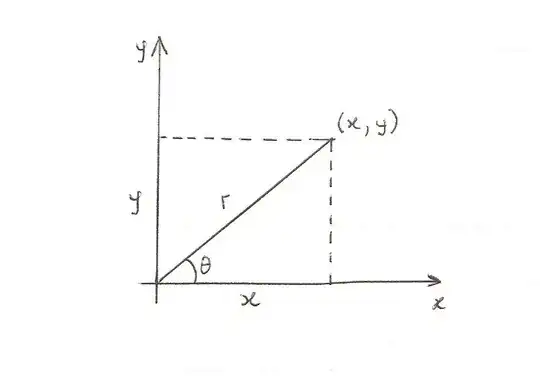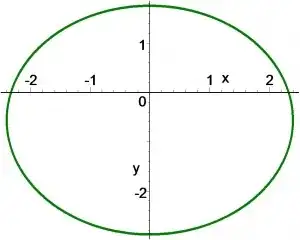Express the curve $r = \dfrac{9}{4+\sin \theta}$ in rectangular form. And what is the rectangular form?
If I get the expression in rectangular form, how am I able to convert it back to polar coordinate?
Express the curve $r = \dfrac{9}{4+\sin \theta}$ in rectangular form. And what is the rectangular form?
If I get the expression in rectangular form, how am I able to convert it back to polar coordinate?
what is the rectangular form?
It is the $y=f(x)$ expression of the curve in the $x,y$ referential (see picture). It can also be the implicit form $F(x,y)=F(x,f(x))\equiv 0$.
Steps:
1) transformation of polar into rectangular coordinates (also known as Cartesian coordinates) (see picture)
$$x=r\cos \theta ,$$
$$y=r\sin \theta ;$$

2) from trigonometry and from 1) $r=\sqrt{x^2+y^2}$
$$\sin \theta =\frac{y}{r}=\frac{y}{\sqrt{ x^{2}+y^{2}}};$$
3) substitution in the given equation $$r=\frac{9}{4+\sin \theta }=\dfrac{9}{4+\dfrac{y}{\sqrt{x^{2}+y^{2}}}}=9\dfrac{\sqrt{x^{2}+y^{2}}}{4\sqrt{x^{2}+y^{2}}+y};$$
4) from 1) $r=\sqrt{x^2+y^2}$, equate
$$9\frac{\sqrt{x^{2}+y^{2}}}{4\sqrt{ x^{2}+y^{2}}+y}=\sqrt{x^{2}+y^{2}};$$
5) simplify to obtain the implicit equation
$$4\sqrt{x^{2}+y^{2}}+y-9=0;$$
6) Rewrite it as $$4\sqrt{x^{2}+y^{2}}=9-y,$$ square it (which may introduce extraneous solutions, also in this question), rearrange as
$$16y^{2}+18y+15x^{2}-81=0,$$
and solve for $y$
$$y=-\frac{3}{5}\pm \frac{4}{15}\sqrt{81-15x^{2}}.$$
7) Check for extraneous solutions.
if I get the expression in rectangular form, how am I able to convert it back to polar coordinate?
The transformation of rectangular to polar coordinates is
$$r=\sqrt{x^{2}+y^{2}}, \qquad \theta =\arctan \frac{y}{x}\qquad \text{in the first quadrant},$$
or rather $\theta =\arctan2(y,x)$ to take into account a location different from the first quadrant. (Wikipedia link).
As commented by J.M. the curve is an ellipse. Here is the plot I got using the equation $16y^{2}+18y+15x^{2}-81=0$.

$$ 4r + 4r\sin\theta = 9. $$ Therefore $$ \sqrt{x^2+y^2} + 4y = 9. $$ $$ \sqrt{x^2+y^2} = 9 - y. $$ Now square both sides and go on from there.
But remember that squaring both sides can lead to extraneous roots. For example $3^2=9$ and $(-3)^2=9$, so a "$\pm$" is introduced when you go back to the unsquared form. In other words, the graph you get after squaring may contain additional points beyond those you should get, and you have to check for those.